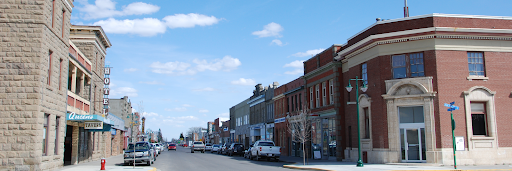
Old Strathcona Provincial Heritage Area - A Commercial District
Strathcona was once it’s own city, located on the south side of the North Saskatchewan River. It’s early rapid growth was due to the arrival of rail in 1891. Edmonton, on the north side of the river, experienced more robust commercial development so the two amalgamated in 1912. Strathcona’s commercial activity continued to falter, with little investment in redevelopment, resulting in the retention of many of the historic buildings. In the 1970s, Edmonton city council bought many properties along 104 Street in preparation for a freeway through the historic area. A "Save-the-district" movement emerged, the Old Strathcona Foundation was formed, and the plan was abandoned. Old Strathcona continued to evolve organically, providing an eclectic mix of goods and services that appealed to local residents and students at the University of Alberta.
In 2005, Edmonton City Council requested that the province designate the area as a Provincial Heritage Area. Edmonton’s Old Strathcona is only one of two such protected areas in Alberta. Designation was granted in 2007 and covers approximately five city blocks from 85 Avenue south to 80 Avenue and from 102 Street west to 106 Street. Early construction was wood-frame (e.g. the Strathcona Hotel and the Orange Hall) so in 1902 the Town Council passed bylaw to prevent wood construction. Other commercial, cultural, and public buildings, many constructed of brick between 1891 and 1914, contribute to the district's heritage value, including the Canadian Pacific Railway Station, the Dominion Hotel, the South Side Post Office, the Gainers Block, the Douglas Block, the Crawford Block, the Princess Theatre, Fire Hall #1 (now Walterdale Theatre), and the second Firehall #6 (mostly demolished except for exterior brick walls and tower, and rebuilt for the Varscona Theatre). Several individual buildings are protected both provincially and municipally. Municipal designation offers such financial incentives as direct grant payments for specific rehabilitation costs, ongoing maintenance financial incentives, zoning regulation variances and other incentives or relaxations deemed appropriate by City Council.
Old Strathcona has an active Business Association and is now home to many of Edmonton's arts and entertainment facilities, as well as a local shopping hub and festival site. The district centres on Whyte (82) Avenue, is a local shopping hub and is popular for its restaurants, bars and buskers. In 2014, Old Strathcona joined the Alberta Main Street Program.
Sources and further reading...
Alberta Register of Historic Places
The Old Strathcona Business Association

The Fort Macleod Provincial Historic Area - A Commercial District
Fort Macleod was founded in 1874 with the arrival of the North West Mounted Police. A community of settlers and businesses that serviced the cattle industry formed outside of the fort. By 1892 when the Calgary and Edmonton Railway reached the community, the town was large enough to become incorporated.
Development of the town's centre continued until 1906 when a fire on Main Street destroyed most of the wood frame structures. Town Council then passed a bylaw requiring future buildings to be constructed of brick or stone, which was sourced locally. Optimism for growth continued, and by 1911 the Fort Macleod Board of Trade was promoting the town as the hub of southern Alberta.
In the 1980’s, Fort Macleod participated in Alberta Main Streets, a program that helped reverse the long term effects of depopulation and service decline experienced by many smaller communities throughout the province. Restoration of the original Edwardian Classical Revival buildings was funded by a grant from In the province in 1982. In 1984, Main Street Fort Macleod became the first Designated Historic Area in Alberta and only one of two protected areas in the province.
The Fort Macleod Provincial Historic Area encompasses approximately 6 blocks of Fort Macleod's commercial core. Of the downtown buildings that contribute to the area, five were built prior to the 1906 fire, all having been faced with brick or locally quarried sandstone. The Territorial Court House, now the town hall (1902 - 04) was designated by the province in 1979 and became a National Historic site in 1980). Four other historic buildings, including the iconic Empress Theatre (built 1912, provincially designated in 1982) round out the mix of government, commercial, financial, hospitality and entertainment uses needed to service townsfolk and the broader rural community.
The town promotes walking tours of the area that explain the past uses of the historic buildings. Many films have been shot using the main street as the backdrop, the most recent being “Let Him Go” starring Kevin Costner, released in 2020.
Sources and further reading:
Alberta Register of Historic Places
Waymarking : Fort Macleod Provincial Historic Area



